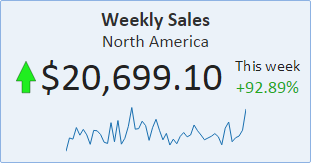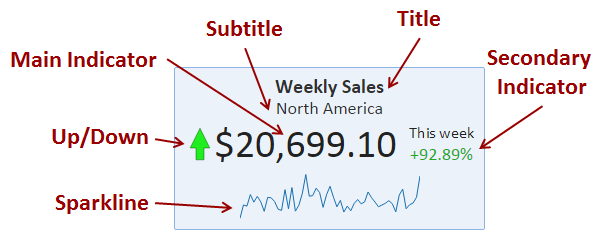Difference between revisions of "Scorecard View"
Gadiyedwab (talk | contribs) |
Gadiyedwab (talk | contribs) |
||
| Line 30: | Line 30: | ||
In fact, we will rarely create a scorecard from scratch. Instead, we will create a scorecard in one of two ways: | In fact, we will rarely create a scorecard from scratch. Instead, we will create a scorecard in one of two ways: | ||
| − | * [[Scorecard view from a pivot]] | + | * [[Scorecard view from a pivot]] - A pivot view is a great tool for calculating the main indicator. We can then instantly add a trend (sparkline) indicator to the scorecard. |
| − | * [[Scorecard view from a timeline chart]] | + | * [[Scorecard view from a timeline chart]] - A timeline view can provide both the main indicator and its trend. |
{{Template:TOC|Computers without Antivirus|Scorecard View from a Pivot}} | {{Template:TOC|Computers without Antivirus|Scorecard View from a Pivot}} | ||
Revision as of 18:41, 17 February 2015
Introduction
A scorecard view highlights a calculated indicator value and is often used as a building block for an analytical dashboard or scorecard.
Scorecard Items
In addition to the main indicator, a scorecard view can have additional parts as illustrated in the following picture:
- Main Indicator - At the center of the scorecard is the main indicator. Other items can be positioned above, below, left or right of the main indicator.
- Title - defines the main indicator
- Subtitle - further qualifies the information in the main indicator
- Secondary Indicator - show information related to the main indicator such as the change from the previous time period. The secondary indicator can have a label. A scorecard view can have any number of secondary indicators.
- Up/Down - a scorecard view can have one up/down. It can be next to the main indicator or next to a secondary indicator.
- Sparkline - a timeline showing trend information leading to the current value of the main indicator. The sparkline is created using a timeline chart. A scorecard view can have one sparkline.
Drill Down
Clicking on a scorecard can display details about the main indicator by displaying the view that calculates the main indicator. From that view, you can further drill to details.
Clicking on the sparkline can display the timeline chart that is used to display the sparkline. This can provide more detail and allow further drill to details.
Creating a Scorecard View
To create a scorecard view, we need to make calculations and draw a timeline. We already know how to make calculations and draw a timeline, and so there’s no need to introduce a new way of doing the same thing. In fact, a scorecard view simply builds on other views such as a timeline chart or a pivot view to provide the needed data.
In fact, we will rarely create a scorecard from scratch. Instead, we will create a scorecard in one of two ways:
- Scorecard view from a pivot - A pivot view is a great tool for calculating the main indicator. We can then instantly add a trend (sparkline) indicator to the scorecard.
- Scorecard view from a timeline chart - A timeline view can provide both the main indicator and its trend.

